
The Qing dynasty, officially the Great Qing, was the last imperial dynasty of China. It was established in 1636, and ruled China proper from 1644 to 1911. It was preceded by the Ming dynasty and succeeded by the Republic of China. The Qing multi-cultural empire lasted for almost three centuries and formed the territorial base for modern China. It was the fifth largest empire in world history. The dynasty was founded by the Manchu Aisin Gioro clan in Manchuria. In the late sixteenth century, Nurhaci, originally a Ming vassal, began organizing "Banners", military-social units that included Manchu, Han, and Mongol elements. Nurhaci united Manchu clans and officially proclaimed the Later Jin dynasty in 1616. His son Hong Taiji began driving Ming forces out of the Liaodong Peninsula and declared a new dynasty, the Qing, in 1636.

Dao are single-edged Chinese swords, primarily used for slashing and chopping. The most common form is also known as the Chinese sabre, although those with wider blades are sometimes referred to as Chinese broadswords. In China, the dao is considered one of the four traditional weapons, along with the gun, qiang (spear), and the jian. The dao is known as "the general of all weapons".

The Yongzheng Emperor, born Yinzhen, was the fifth Emperor of the Qing dynasty, and the third Qing emperor to rule over China proper, reigned from 1722 to 1735. A hard-working ruler, the Yongzheng Emperor's main goal was to create an effective government at minimal expense. Like his father, the Kangxi Emperor, the Yongzheng Emperor used military force to preserve the dynasty's position. His reign was known for being despotic, efficient, and vigorous.

Aisin Gioro was the Manchu ruling clan of the Later Jin dynasty (1616–1636), the Qing dynasty (1636–1912) and, nominally, Manchukuo (1932–1945). The House of Aisin Gioro ruled China proper from 1644 until the Xinhai Revolution of 1911–1912, which established a republican government in its place. The word aisin means gold in the Manchu language, and "gioro" is the name of the Aisin Gioro's ancestral home in present-day Yilan, Heilongjiang Province. In Manchu custom, families are identified first by their hala (哈拉), i.e. their family or clan name, and then by mukūn (穆昆), the more detailed classification, typically referring to individual families. In the case of Aisin Gioro, Aisin is the mukūn, and Gioro is the hala. Other members of the Gioro clan include Irgen Gioro (伊爾根覺羅), Šušu Gioro (舒舒覺羅) and Sirin Gioro (西林覺羅).

Yinxiang, formally known as Prince Yi, was a Manchu prince of the Qing dynasty. The thirteenth son of the Kangxi Emperor, Yinxiang was a major ally of his brother Yinzhen during the latter's struggle for the succession of the throne. He was made a qinwang during Yongzheng's reign and became one of his closest advisors. He died eight years into the reign of the Yongzheng Emperor and was memorialized with top honours by the emperor. When he died, his title was granted "iron-cap" status and became perpetually inheritable, one of the only twelve such princes in Qing dynasty history.
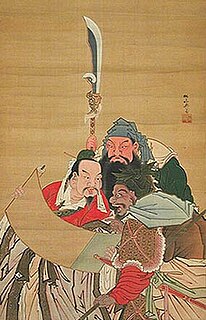
A guandao is a type of Chinese pole weapon that is used in some forms of Chinese martial arts. In Chinese, it is properly called a yanyuedao, the name under which it always appears in texts from the Song to Qing dynasties such as the Wujing Zongyao and Huangchao Liqi Tushi. It is comparable to the Japanese naginata and the European fauchard or glaive and consists of a heavy blade with a spike at the back and sometimes also a notch at the spike's upper base that can catch an opponent's weapon. In addition there are often irregular serrations that lead the back edge of the blade to the spike. The blade is mounted atop a 1.5 m to 1.8 m (5–6 foot) long wooden or metal pole with a pointed metal counter weight used to balance the heavy blade and for striking on the opposite end.
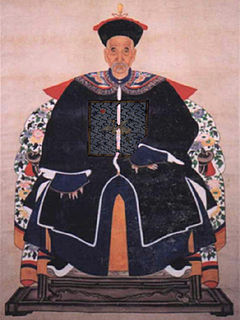
Zhang Tingyu was a Han Chinese politician and historian who lived in the Qing dynasty.
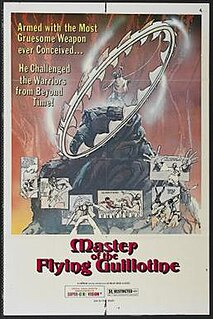
Master of the Flying Guillotine is a 1976 Taiwanese wuxia film starring Jimmy Wang Yu, who also wrote and directed the film. It is a sequel to Wang's 1971 film One Armed Boxer, and thus the film is also known as One-Armed Boxer 2 and The One Armed Boxer vs. the Flying Guillotine.

The Palace of Heavenly Purity, or Qianqing Palace is a palace in the Forbidden City in Beijing, China. It is the largest of the three halls of the Inner Court, located at the northern end of the Forbidden City. During the Qing dynasty, the palace often served as the Emperor's audience hall, where he held council with the Grand Council.
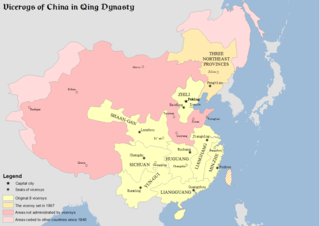
The Viceroy of Liangguang or Viceroy of the Two Guangs, fully referred to in Chinese as the Governor-General, Commander and Quartermaster, Supervisor of Waterways, and Inspector-General of the Two Expanses and Surrounding Areas, was one of eight regional Viceroys in China proper during the Ming and Qing dynasties. The two Guangs referred to Guangdong and Guangxi provinces. The areas under the Viceroy's jurisdiction included present-day Guangdong and Guangxi provinces, as well as Hainan Province.
Li Wei was a prominent mandarin who lived during the reign of the Yongzheng Emperor (1722–1735) of the Qing Dynasty. He was instrumental in carrying out Yongzheng's nationwide reforms in his role in various regional governing positions.
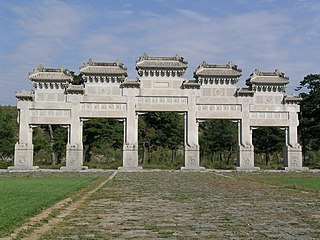
The Western Qing tombs are located some 140 km (87 mi) southwest of Beijing in Yi County, Hebei Province. They constitute a necropolis that incorporates four royal mausoleums where seventy-eight royal members are buried. These include four emperors of the Qing dynasty and their empresses, imperial concubines, princes and princesses, as well as other royal servants.

Yongzheng Dynasty is a 1999 Chinese historical television series starring Tang Guoqiang and Jiao Huang. The series, spanning 44 episodes, occupied the CCTV-1 prime time slot; after its premiere, there have been many re-runs of the show on television networks in mainland China, Taiwan and Hong Kong. The series was adapted from Eryue He's historical novels, which are loosely based on historical events in the reigns of the Kangxi and Yongzheng Emperors in the Qing dynasty (1644–1911). The series was followed by a 2001 prequel, Kangxi Dynasty, and a 2002 sequel, Qianlong Dynasty, both of which were also based on Eryue He's novels.

The Guillotines is a 2012 Chinese-Hong Kong wuxia film directed by Andrew Lau, starring Huang Xiaoming, Ethan Juan, Shawn Yue, Li Yuchun and Jing Boran. It is a remake of the 1975 Shaw Brothers film Flying Guillotine.

Jiangshan Weizhong, also known as Da Qing Diguo, is a 2002 Chinese television series based on legends about the Yongzheng and Qianlong emperors of the Qing dynasty. The series was first broadcast in mainland China in December 2002.

Hero of the Times is a Singaporean-Taiwanese wuxia television series based on legends about Fong Sai-yuk, a Chinese folk hero and martial artist who lived during the Qing dynasty. It was co-produced by the Television Corporation of Singapore and Taiwan's China Television, directed by Hu Mingkai, and starred Chinese actor Vincent Zhao as Fang Shiyu. It was first aired in Singapore on TCS Eighth Frequency from late 1999 to early 2000.
Imperial Noble Consort Dunsu, of the Han Chinese Bordered Yellow Banner Nian clan, was a consort of the Yongzheng Emperor.
Events from the year 1683 in China.
Events from the year 1686 in China.














